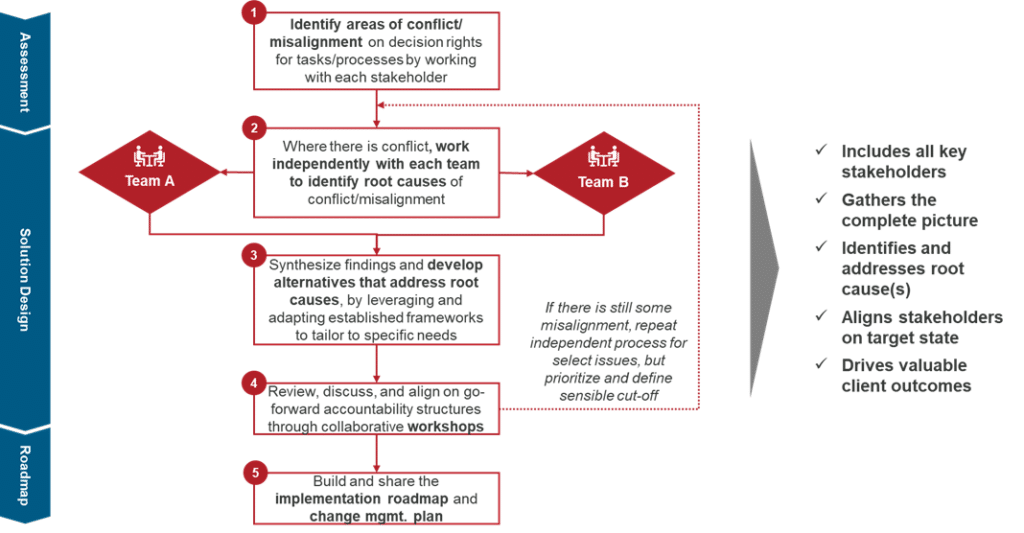Organizations often struggle with building organizational alignment and accountability. While companies often have well-defined accountabilities at the C-suite and upper management levels, accountability at lower levels of the organization can lack clarity, understanding, and detail. Misalignment of roles and responsibilities can result in conflict, ineffective decision-making, poor use of internal capabilities, and duplicated tasks.
In our experience, misalignment challenges often occur in two common areas of organizations:
- At the intersection of business unit leadership and shared enterprise services, such as marketing Centers of Excellence. For example, the senior vice president accountable for driving business results and the Head of Marketing may disagree over who makes the decisions for significant marketing investments.
- At the operating level – that is, where the work gets done – within business units. For example, director and manager-level roles may overlap in accountability for key cross-functional decisions.
The diagram below illustrates where misalignment often occurs within a matrix organizational structure.

Why do we observe these challenges even when established decision-making frameworks like RACI (Responsible, Accountable, Consulted, Informed) have been used to define accountability structures within organizations? While decision frameworks are useful tools, we often observe challenges with the implementation of those frameworks due to several factors, including:
- The frameworks define accountability structures quite well at the C-level, but lack detail at lower levels, such as for vice presidents and directors.
- Frameworks often lack the required flexibility to address the organization’s specific needs. For example, the limited number of decision roles within the accountability framework can be too narrow and rigid and does not appropriately account for nuances in how the organization actually operates.
- Insufficient rigour during implementation and a lack of focus on change management can lead to disagreement and a lack of buy-in for the go-forward accountability structure.
5 Step approach for solving misalignment within your organization
Through Burnie Group’s experience working with clients in various industries to solve misalignment issues within organizations, we have developed a unique approach for increasing organizational effectiveness.
Our approach tackles the identified issues by flexibly applying and adapting frameworks to make them fit for purpose. Furthermore, our approach starts by working independently with key stakeholders to identify the root causes of misalignment, enabling a more rigorous analysis and solution design.
The five-step approach can be part of a broader organizational effectiveness project and span through the current state assessment, solution design, and road mapping for a successful implementation.

-
Identify areas of conflict and misalignment
Identify the areas of conflict and misalignment by working with all key stakeholders. Conduct leadership interviews and focus groups and review process documentation to gain insight and identify areas “where there is smoke.” Prioritize areas of conflict to focus on the most pressing issues and increase the impact of this approach.
-
Identify the root causes of conflict
Next, provide a platform to identify and understand the root causes of misalignment with perspectives from all stakeholders. Working independently with key stakeholder groups in a confidential manner – with no visibility to the other group’s perspective – enables a more detailed and less constrained analysis of the issues and helps to identify the root causes and core drivers behind the misalignment.
-
Synthesize findings, design alternatives, and flexibly leverage a framework for solution design
Based on the findings from the independent working sessions, develop potential solutions and design alternatives to the current perception of roles and decision rights. The alternative solutions should:
- Build off areas of alignment
- Address root issues identified by all of your stakeholders
- Leverage frameworks, such as RACI, and adapt them to suit your organization’s needs
- Provide a strong foundation to resolve the conflict
As an example of adapting frameworks, a past client used the RACI framework to define decision-making between a line of business and a central marketing centre of excellence. We introduced the Consulted+ role type (C+) to the framework to add flexibility to the RACI framework and address client-specific needs for collaboration. For certain decisions, the organization needed to thoughtfully consider input from C+ for any final decision-making to acknowledge the heightened importance of input and collaboration. Adding the C+ to the RACI framework enabled the organization to align on the go-forward accountability structure and improve decision-making.
-
Determine the go-forward accountability structure through a collaborative workshop approach
Once a set of alternatives is developed, review, discuss, and align on the go-forward accountability structures through a collaborative workshop. During the workshop, you should:
- Share the areas of misalignment and root causes from both perspectives with all key stakeholders
- Highlight areas of alignment as the common ground for discussion
- Help teams understand where they are aligned and where misalignment is rooted
- Present the most suitable alternatives that address the root causes and allow for alignment on the go-forward accountability structure, with buy-in from all key stakeholders
If there are still areas of misalignment after the workshop, repeat the process from Step 2 to identify the root causes of conflict until all stakeholders align on the go-forward structure. Implement a reasonable cut-off time to prioritize alignment on the most critical areas and avoid repeating the process indefinitely. Typically, teams resolve their issues and come to an agreement in one session, with one additional follow-up session to review any takeaways and wrap up any loose ends.
-
Create an implementation roadmap and change management plan
Lastly, develop a roadmap and change management plan to ensure a successful implementation of your go-forward decision-making structure. The change management plan ensures that leadership and employees commit to the change, regularly communicate organizational updates, and implement a governance structure. Buy-in from all key stakeholders is critical for a successful implementation. The results are a more effective and efficient decision-making process from the C-level to the working levels.
Outcomes to expect from our approach
Burnie Group worked with a client to help them define accountabilities and achieve organizational alignment. First, we gathered perspectives on the current state of roles through independent, confidential working sessions with both teams. Next, we developed and shared areas of alignment, root issues behind misalignment, and potential alternatives through collaborative workshop sessions with all key stakeholders. This process enabled us to gain alignment and agree on the go-forward accountability structure. Finally, we introduced the Consulted+ role to leverage an established framework (RACI) and adapt it to the specific client need to solve misalignment.
Read our case study on our alignment project with a financial services client.
READ THE CASE STUDYKey success factors of the 5-step approach to solving misalignment
The five-step approach results in improved organizational alignment due to several factors:
- It adapts frameworks as necessary to fit your organization’s specific requirements
- The independent, confidential work with all key stakeholders enables your team to successfully identify the root causes behind misalignment, and truly understand different perspectives
- Solutions are designed to address the identified root causes of conflict directly
- The structured, iterative approach ensures that all areas of conflict are addressed, and secures buy in on solution design across stakeholders
- The detailed roadmap and change management plan drive a successful implementation
Burnie Group has extensive experience resolving accountability conflicts and improving organizational alignment. Reach out to us to find out more about our Strategic Alignment Program.
About the authors
Read more of our insights on operations
Learn more about our approach to improving organizational alignment.
CONTACT US






